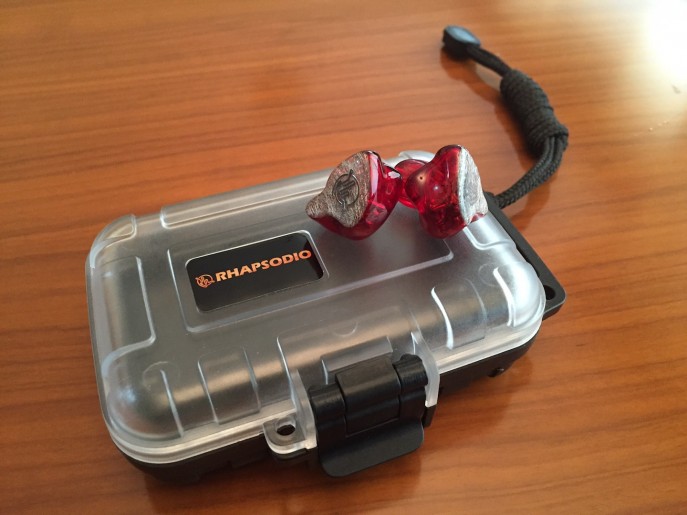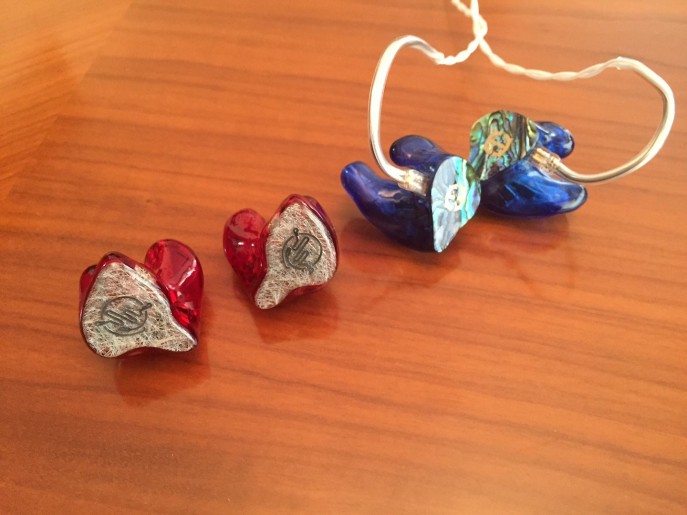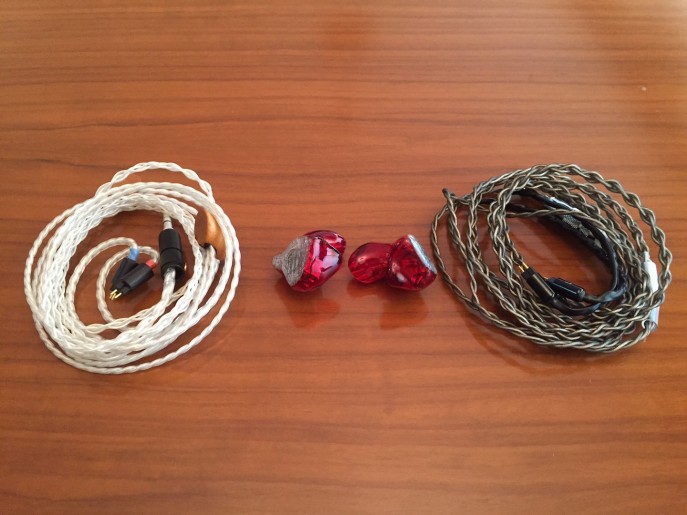Rhapsodio is a Hong Kong based company that produces in ear monitors and upgrade cables. Rhapsodio’s owner, Sammy, has a strong background and tuned many different in ear monitors such as Hybrid Series, Solar series and Galaxy Series. While Solar series utilize balanced armature drivers, Galaxy series are powered with UltraMag dynamic drivers. In Solar series, there are two versions of the same tuning: custom and universal. The reviewed unit is custom made and consists of 10 balanced armature drivers per side. Sammy also offers some high quality aftermarket cables such as Litz and Pandora series. My favorite is 2.98SG/8 braided cable that has a very strong imaging and resolution.
Build Quality and Accessories:
The reviewed unit is refitted, since there was a slight disturbance at the left side. Sammy quickly handled and remade it. After refit process, the monitors become quite comfortable. Even during long listening sections, I have no pain at all. I like the body color as well as beautifully crafted faceplate with Rhapsodio’ logo.
As I mentioned before, Rhapsodio Solar is powered with 10 balanced armature drivers (2 tweeters, 2 highs, 4 mids and 2 bass) with a 4 way passive crossover system. There are 3 main acoustic ways; one of them is bigger than two. According to Rhapsodio website, the impedance of the monitor is 26 OHM. Solar has industry standard 2 pin sockets. They are neither too tight nor too loose; I think that they have good durability.
The stock cable of Solar is from Pandora Series, SPC Pandora. Pandora utilizes 4 silver plated conductors; on the other hand, many standard cables have 3 braids as standard. Overall build quality of Pandora is nice, but it is not as soft and flexible as Westone’s standard cables. In addition, Pandora has 3.5mm golden plated plug and good quality 2 pin connectors. However, I find its memory wire a bit long and rough.
Sound:
Rhapsodio Solar is warm and dynamic sounding unit with a slight V shape signature. Some may find its atmosphere a little dark, but high frequency has a little bright tone creates detailed and alive presentation.
This review is about custom version of Solar. So, please note that universal version may differ in accordance with tips used and insertion depth. During critical listening, Solar was tested on Lotoo Paw Gold and the BIT Opus1.
Low Frequency:
Solar has powerful and punchy sub-bass hits. Hitting to depth ability is quite good and overall tonality can be seen as natural. Resolution and texture are good; Solar has a fast response in sub-bass region, but ‘’hanging in the air’’ time could be a little longer.
Even so Solar has V shape response, the energy focus of the overall presentation leans towards to low frequency due to the prominent and intensive mid-bass’ notes. In general, mid-bass’ notes don’t tighten the stage. However, if the quantity is plenty in the track, the mid-bass band can be thickened and the background becomes a little congested. On the other hand, mid-bass provides a nice musicality, softness and body.
Mid Frequency:
The midrange of Solar isn’t located very distant, thanks to full bodied and weighty notes. Indeed, Solar is very dynamic and powerful, also creates full-bodied instruments. Parenthetically, vocals sound a little closer to listener, when compared to instruments’ locations. Average note thickness is on the thicker side, but it may sound a bit too thick due to the possible mid-bass thump depending on tracks. Resolution and transparency levels are not very high, but enough for a flagship. Solar isn’t very forgiving in upper-midrange, since there is a slight brightness here.

High Frequency:
Solar has prominent treble notes, but it doesn’t have a forward presentation. Control and resolution is good, but tonality isn’t so close to true tone. Despite that, Solar’s treble tonality can be accepted in natural region with non-piercing notes. I don’t find them too sensitive to bad recordings. Speedy Solar can handle cymbals in fast metal tracks, but they are cut a little too early.
Soundstage and Separation:
Solar has effectual stage dimensions; there is no overly wide or super deep stage, but it carries a nice amount of depth to create sufficient space for a good layering. Also, the performing area of Solar isn’t congested and there is a fair distance between instruments. However, this distance is filled with warm air rather than neutral one due to the mid-bass presentation. Thanks to prominent and open-toned treble notes, this warm air doesn’t make Solar a boring custom in ear monitor.
The background of Solar is quite black and stable with strong instrument separation. However, Solar may have congestion pursuant to the mid-bass density depending on tracks and the background may become less clear. This problem may reduce the separation level by a small margin. Imaging and focusing is pretty strong with good coherence ability.
Selected Comparisons:
Rhapsodio Solar vs Spiral Ear SE5 Ref
Overall, Rhapsodio Solar is a warm sounding monitor and Spiral Ear SE5 is closer to have a neutral sound in comparison. Both have natural sounding perspective, but SE5 has truer tone.

Low Frequency:
Solar hits harder in sub-bass region, while SE5’s notes hang longer in the air. Solar’s attack and decay ability is a little faster than necessary. Solar uses larger and more impactful notes, but SE5 offers slightly more resolution in low end.
In mid-bass range, Solar has significantly more prominent and warmer notes; SE5 offers more resolved and detailed presentation. In accordance with the mid-bass quantity, Solar sounds thicker and weightier overall.
Mid Frequency:
Solar has a V-shape signature versus SE5’s mid-centric and open-toned presentation. When viewed from this aspect, the midrange of Solar is located laid back, but sounds with bolder and darkish touches.
On the other hand, SE5’s midrange is more resolved and transparent, and it is better in terms of recreation both thick and thin notes well. Solar may perform too thick and more colored pursuant to mid-bass thump, yet it creates good body for vocals and instruments. Also, Solar is brighter in upper mid-range and tends to sibilance more, while SE5 is less detailed, but smoother in this area.
High Frequency:
In comparison, Solar has more prominent and brighter treble performance. SE5 sounds with less colored and more natural notes. In terms of speed and extension, SE5 has a slight superiority, but Solar seems to be more detailed in accordance with more alive and prominent lower treble. In addition, Solar is less forgiving against bad recordings.
Soundstage and Separation:
Both don’t have a large stage, but Solar has slightly wider one with a similar depth in comparison. Solar has warmer stage structure, while SE5 is much neutral in terms of air between instruments.
However, SE5 seems to be congested while locating instruments. By the same token, Solar may have a background clarity problem when comes to tracks dominated by mid-bass’ notes. Solar slightly betters SE5 in terms of imaging, but SE5 allows focusing a little easier.
Rhapsodio Solar vs Empire Ears Zeus (Custom version)
As it is in the SE5 comparison, Solar has a V shape signature and Zeus has mid-centric approach. Overall, Zeus has open-tone, while Solar is bolder and warmer; both have a musical approach, but Zeus sounds more technical.
Please note that EE Zeus universal version may have some differences.

Low Frequency:
Solar has more impactful hits, while Zeus has cleaner and more analytic sub-bass structure in comparison. Resolution and texture levels are similar; both have fast sub-bass’ response. Solar’s tone is more emotional, while Zeus follows a more technical way here. Like sub-bass range, Solar has more mid-bass quantity with a warmer tone. Due to mid-bass presentation difference, Solar may sound too warm and have background congestion versus Zeus’ airier approach. Mid-bass’ resolution level is higher on Zeus; Solar misses some little nuances.
Mid Frequency:
Zeus sounds more forward and aggressive with slightly thinner and cleaner notes; Solar’s midrange is located laid-back in comparison. Resolution and transparency are better on Zeus; Solar has hollow midrange presentation. Zeus is better in terms of note recreation and articulates details more than Solar does. Both have slight brightness in upper midrange; Zeus has more forward notes, while Solar is smoother and less stressed. Vocals are fuller on Solar by a small margin, but Zeus has more resolved and transparent vocals. However Zeus tends to sibilance more.
High Frequency:
Zeus has slightly more alive treble notes, while Solar is weightier and warmer in high frequency presentation. Zeus sounds brighter and cleaner in accordance with its general character and low end’s dominancy of Solar. The overall treble speed and resolution level is similar, but Zeus is slightly more extended. Both aren’t very forgiving against bad recordings.
Soundstage and Separation:
The overall stage depth is better on Zeus and it is airier with a bit wider stage. Zeus spreads neutral air between instruments, while Solar has much warmer air in the area due to mid-bass presentation. Both have an impressive instrument separation, but Solar’s background is blacker by very small margin. On the other hand, Zeus has definitely clearer and cleaner background. Zeus has better imaging, but Solar is more coherent with a bit better focusing ability.
Rhapsodio SG2.98 4 Strands Cable on Solar:
As we all know, Solar comes with Pandora cable as standard. 2.98, old RSD flagship cable, is a hybrid unit and made by silver/alloy material. Overall, it has a warm sound and offers higher resolution notes. It doesn’t carry the characteristics of a regular silver cable.

In general, 2.98 cable reduces low frequency’s quantity by a very small margin and makes sub-bass tighter and cleaner. Also, mid-bass becomes more controlled and the thump is becoming smaller. When compared to Pandora stock, 2.98 cable offers a little more forward midrange, but Solar still keeps V-shape signature. The resolution is slightly improved and instruments become cleaner and a bit more transparent. Overall treble tone is similar, but 2.98 cable creates more resolved and slightly clearer high frequency presentation. The width difference is not very significant, but 2.98 cable has deeper stage and better layering as well as a bit better separation.
Note: 2.98 8 strands cable is a definite upgrade over 2.98 4 strands. Apart from its synergy with Solar, tone and imaging gets perfect with 8 strands.
Final Words:
Rhapsodio Solar is non-fatiguing, warm tuned and dynamic sounding custom in ear monitor. If the expectation about transparency is not very high, with its strong instrument separation, Solar would be a good alternative for who prefers warm atmosphere and musical signature. The craftsmanship is also very nice and comfort is pretty good for long listening sections.
The MSRP is 1550 USD for the custom version of Solar.
Please check the links for further information:















Want to join discussion?
Feel free to contribute!